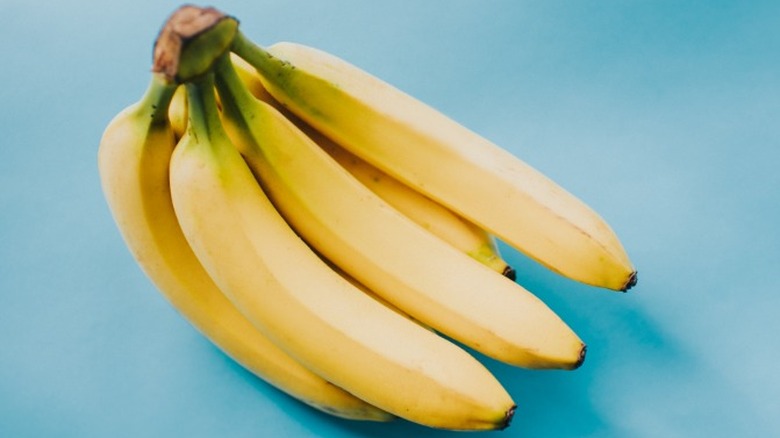This Small Detail Could Mean You're Picking Bad Bananas
Whether you want to make classic banana bread or simply enjoy eating a banana every day as a snack, it's important to know how to pick the best bunches at the store. If they're too green, you won't want to dig in until they ripen. If they're too brown, you may be stuck looking for ways to use overripe bananas. But beyond color, there is one little detail that will help you figure out if you're grabbing undesirable fruit.
You probably wouldn't buy a banana that is halfway peeled. Along the same lines, you should purchase the ones that still have their necks and stems intact. If you see any of the fruit within the peel, that's a good indicator that you should leave that banana behind. That's because it may have been exposed to germs as well as oxygen. In a similar vein, according to the USDA, peeled fruits and veggies should not be left out at room temperature for more than two hours. (Even though a banana with a damaged neck isn't technically peeled, you don't want to give air and bacteria an hours-long or days-long head start.) Additionally, the FDA recommends purchasing produce that is not bruised or damaged to avoid food-borne illnesses.
Moreover, if you prefer bananas more yellow than brown, sticking to the ones with intact necks will slow down the natural oxidation processes. The fruit contains a chemical called polyphenol oxidase, which reacts with oxygen in the air, resulting in oxidation (browning). Breaking the skin will force the banana to undergo this process sooner.
Keep stems and necks covered to prevent quick ripening
So you've bought bananas with their necks still attached, how do you keep them ripe for as long as possible? It turns out that the stem is yet again instrumental. Sometimes bunches are sold with their tops wrapped up in plastic, which keeps them fresher for longer. This is actually because they produce ethylene, a hormone that plays a big role in the ripening process. Bananas are what are called climacteric fruits, which means that they have the ability to ripen after harvesting. Climacteric fruits release larger amounts of ethylene as they get further in the ripening process, which speeds up maturation.
Additionally, damaged fruits will produce more ethylene (yet another reason not to purchase bananas with broken stems). If your store-bought bunch doesn't have its stems covered already, you can do it yourself using plastic wrap. As it turns out, this extra step could also protect some of the other fruits and vegetables in your kitchen. The ethylene produced by bananas will not solely impact the bunch, but can travel to other sensitive produce. These can include apples, grapes, cucumber, onions, and even lemons. If stored near each other, these items will enhance each other's ripening processes.

